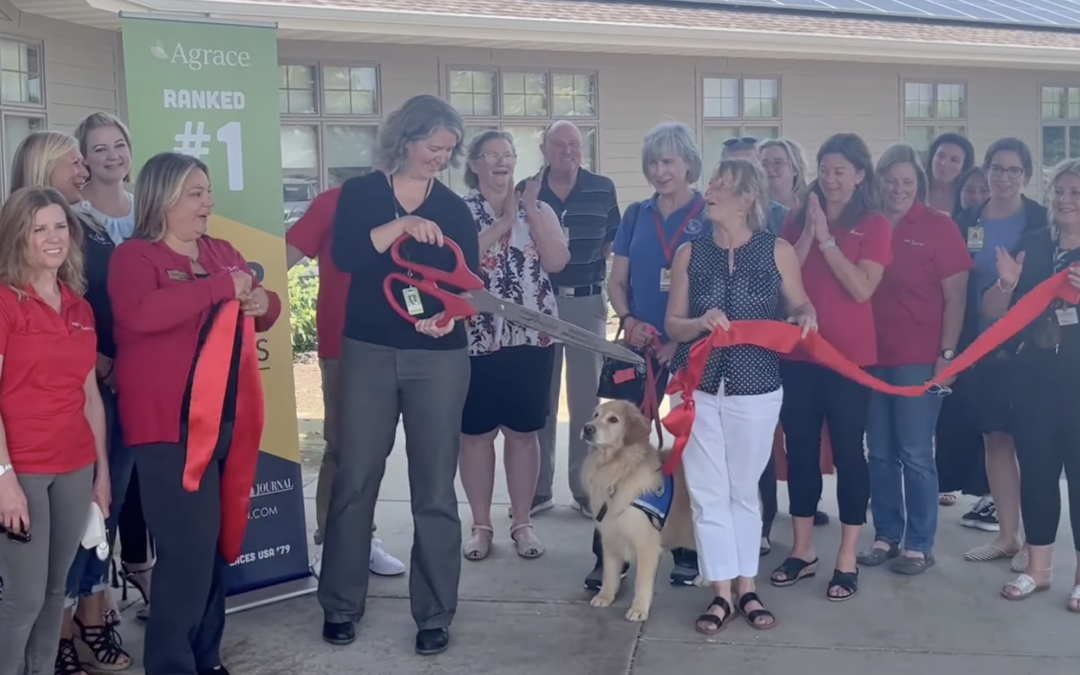
by Lauren Cohen | Jun 29, 2023 | Programs, Solar, Solar for Good
On Tuesday, June 20th, Agrace Hospice Care commemorated the completion of its 87-kilowatt solar array with a ribbon cutting. Founded in 1978, Agrace Hospice Care is a nonprofit whose mission is to provide personalized care and support for life’s changing health needs.
Installed by Full Spectrum Solar, their 212-panel solar system is projected to produce 343,481 kilowatt hours annually, offsetting 31% of the organization’s annual usage. This solar system is just one aspect of Agrace’s plan for carbon neutrality by 2025. “There are absolutely financial savings that we will begin to enjoy a decade from now, but that’s not high on our reasons for doing this,” said Lynn Sexten, CEO of Agrace. “Making sure our services are available to anyone, regardless of their ability to pay, means we’re making sure we’re being a good corporate citizen, a good community partner, and helping to further cleaner air in our local communities.”
This project was made possible thanks mainly to Focus on Energy incentives and a Solar for Good grant. Created in partnership with the Couillard Solar Foundation, RENEW Wisconsin’s Solar for Good program provided Agrace Hospice Care with a $10,000 grant to use toward their solar project.
As a nonprofit, Agrace strives to allocate as many resources as possible to direct caregiving and community services. The funds saved through this solar project will be reinvested in Janesville and other areas, ensuring the continued provision of exceptional care to those in need. By embracing solar energy and other initiatives that reduce its carbon footprint, Agrace sets an example for sustainable practices within its organization and the wider community.
To achieve their ambitious carbon-neutral goals, completing the solar array at their Janesville facility is just the beginning of Agrace’s commitment to renewable energy. They also have plans to install a solar array at their Madison facility, further emphasizing their dedication to environmental stewardship. Agrace aims to raise awareness about the positive impact of solar power on reducing operational costs, allowing for increased investment in patient care and community programs for years to come.
By embracing solar energy, Agrace demonstrates its determination to minimize its carbon footprint and allocate resources where needed most. As they continue expanding their renewable energy initiatives, Agrace paves the way for a brighter and more sustainable future for their organization and the communities they serve.
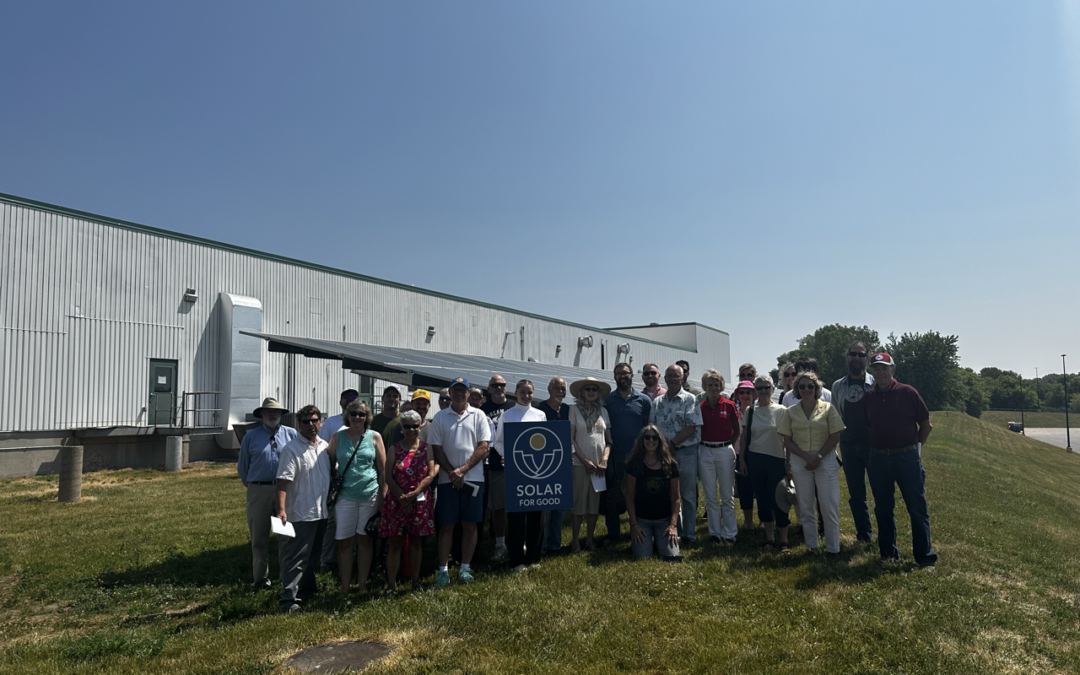
by Lauren Cohen | Jun 29, 2023 | Programs, Solar, Solar for Good
On Tuesday, June 20th, Vernon Economic Development Association (VEDA) celebrated the completion of their 100-kilowatt solar array. Vernon Economic Development Association is a nonprofit that is dedicated to strengthening its community through economic development by bringing state and federal resources to its region.
The 180-panel ground-mounted array, designed and installed by Ethos Green Power Cooperative (EGPC), was installed on the Food Enterprise Center and is projected to produce nearly 130,000 kilowatt-hours annually, offsetting approximately 60% of the shared space usage.
“The electricity generated supports our common areas that serve small tenant businesses and refrigeration coolers produce and dairy produce storage for VEDA’s Community Hunger Solutions Program, which brings nutritious food to community members who lack access,” said Susan Noble, Executive Director of VEDA. This solar project is a critical part of our sustainability plan and a long-term solution fostering a stronger, more stable community.”
Several grants made this project possible, including Focus on Energy, Solar Moonshot, the BQuest Foundation, Associated Bank, GoMacro, Vernon Communications, EGPC Community Power Program, and individual community member donations.
VEDA also received a grant from Solar for Good, a RENEW Wisconsin program created in partnership with the Couillard Solar Foundation to help nonprofits go solar. Solar for Good awarded the organization half of the solar panels needed for their project.
This solar project will save the organization valuable dollars, which can then be reinvested into its mission and community. “It is clearly a powerful investment which will save $300,000 in electricity costs over 25 years that can be put towards other operations and helping more businesses grow,” said Mike Breckel, president of VEDA’s Board of Directors.
“Being able to utilize and demonstrate solar power to the community and the region is consistent with our mission to create sustainable economic growth that increases the prosperity and well-being of the people of this region while protecting and enhancing the area’s unique environment, which is the foundation of our rural lifestyle and quality of life,” continued Noble.
With over 20 businesses located at the Food Enterprise Center, this solar array will have a wide-reaching impact on its tenants and customers. Installations like VEDA highlight the long-term economic benefits of renewable energy investments. As a well-known and well-respected organization in their region, this solar installation will be an example to other community members.
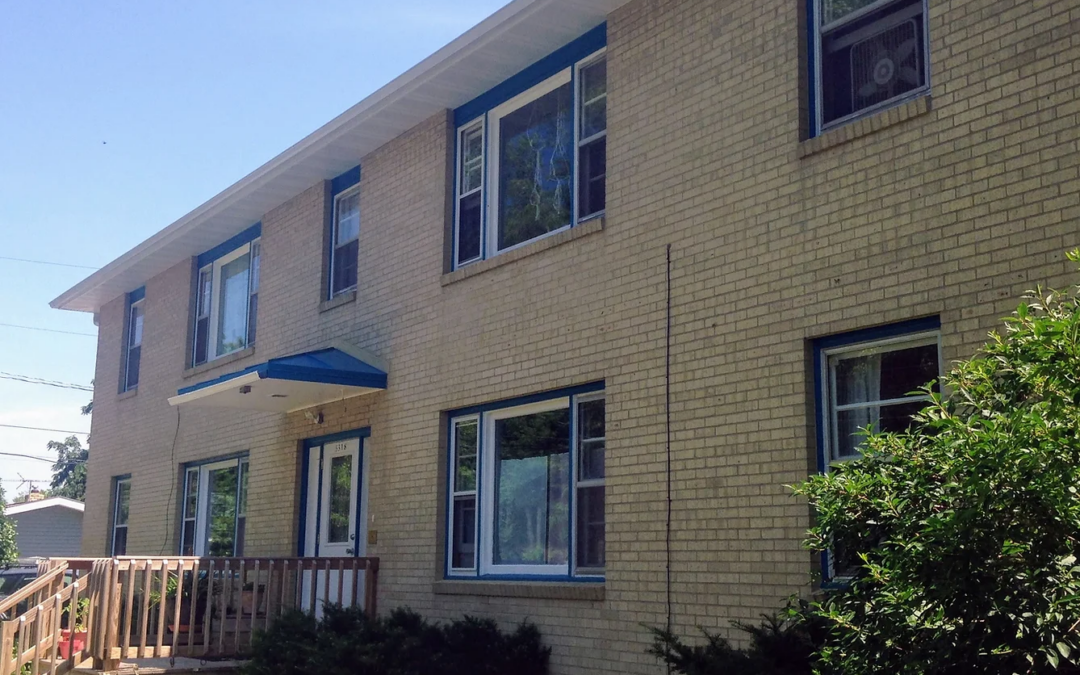
by Lauren Cohen | Jun 29, 2023 | Programs, Solar, Solar for Good
On Friday, June 15, RENEW Wisconsin joined Madison Area Cooperative Housing Alliance (MACHA) to celebrate the completion of their 14.4-kilowatt solar array, made possible in part by MadiSUN Backyard Solar and Solar for Good grants. MACHA is a nonprofit organization that seeks to promote resilience and equity in the Madison area by supporting the continuation and creation of cooperative housing.
This solar system was installed by Full Spectrum Solar and is projected to offset 97% of the building’s electricity usage for Perennial Co-op’s 11-person house, ensuring long-term affordability for its residents. The cooperative house will benefit from reduced utility bills by leveraging solar energy.
The installation was made possible through the support of several grants and incentives. The MadiSUN Backyard Grant, a program that awards grants to Madison-based nonprofits, awarded MACHA $9,725. In addition, MACHA also received a grant from Solar for Good, a program whose mission is to foster solar expansion among Wisconsin nonprofits. MACHA also received funding from Focus on Energy and loan support from Greenpenny.
The completion of this solar array comes at a critical time within the Madison housing market. “With housing costs in Madison increasing, more and more people are priced out of the housing market,” said Steve Vig, Secretary with MACHA. “Cooperative housing ensures long-term affordability, as does the transition to renewable energy infrastructure such as solar. Perennial Co-op sets an example for long-term affordability, climate-resiliency, and multi-generational living.”
Madison Cooperative Housing Alliance plans to use Perennial Co-op’s solar array as an example that other similar organizations can replicate. “We hope that Perennial Co-op’s new solar array can serve as a model for other cooperative houses in Madison,” said Gabrielle Hinahara, MACHA Board Member. “MACHA would be excited to collaborate with more co-op houses interested in installing solar. These projects are a win-win because they contribute to our community’s environmental sustainability and provide long-term financial sustainability for our cooperative houses, which often house residents with modest incomes.”
The completion of this solar array marks a significant milestone for promoting resilience, affordability, and sustainability in the Madison housing market. With housing costs rising, cooperative housing, coupled with renewable energy infrastructure, presents a solution for long-term affordability and sustainability. With this installation completed, other organizations have a laid-out path to follow suit, fostering an environmentally and economically viable community for Madison residents.
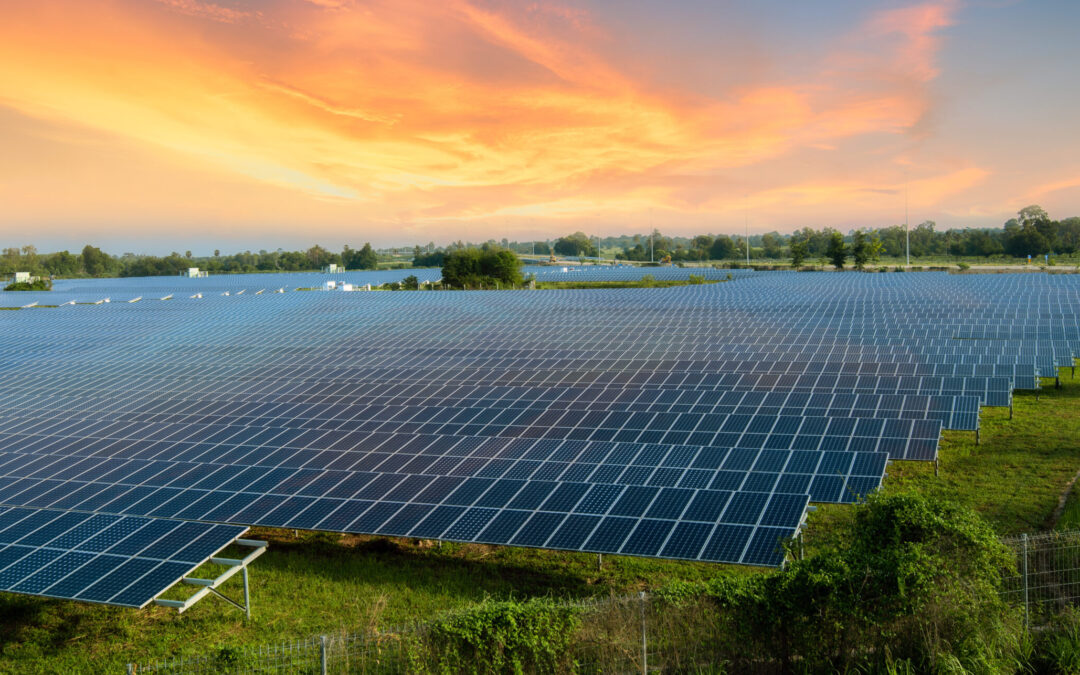
by Michael Vickerman | Jun 29, 2023 | Solar, Utilities, Utility Scale
Wisconsin electric providers added significantly more renewable energy content to their electricity supplies in 2022, according to a June 2023 report issued by the Public Service Commission. Overall, renewable energy accounted for 16.2% of Wisconsin electricity sales in 2022, increasing more than two percentage points from the 13.8% level recorded in 2021.
Renewable energy performance varied widely among individual electric providers. At the high end, Northern States Power-Wisconsin (Xcel-NSPW) reported that 44.5% of the electricity it sold in 2022 came from renewable energy sources (see Table 1). Though making up only 10% of Wisconsin electricity sales, Xcel-NSPW accounts for nearly 27% of the state’s total renewable electricity supply. Most of the utility’s added renewable energy supplies came from wind power projects in Minnesota and the Dakotas.
Wisconsin Power and Light (Alliant-WPL) also posted healthy gains in 2022, rising from 20.2% in 2021 to 24% last year. Indeed, of the 11.3 million megawatt-hours (MWh) of renewable energy sold in Wisconsin in 2022, about one-half of that total (5.7 million MWh) flowed through either Xcel-NSPW or Alliant-WPL to their customers.
Under the state’s Renewable Portfolio Standard (RPS), electric providers must track their renewable energy sales from the previous year and provide those results to the Public Service Commission. The 2022 results are retrievable from the Commission staff memo issued in Docket 5-RF-2022, specifically Appendices D and E of PSC REF#: 470111. These annual reports also compile renewable electricity provided through utility renewable energy tariffs, such as community solar offerings.
The PSC’s RPS reports break down aggregate renewable power totals by resource and state of origin. Imports from other states accounted for nearly two-thirds of total renewable electricity sales (64% vs. 36%). In 2022, wind projects generated 74% of the renewable electricity sold in Wisconsin, followed by hydro (14%), solar (7%), and biomass (4%). Moving in with greater granularity, wind power originating from out-of-state sources accounted for 59% of total renewable energy sales, followed by in-state wind (15%), in-state hydro (10%, and in-state solar (6%).
The percentage of out-of-state wind generation relative to total renewable electricity sales has increased dramatically since 2017, rising from 48% to 59%.
Tracking individual utility performance
In the wake of utility commitments to substantially reduce carbon emissions by 2030 and reach net zero emissions by 2050, these compliance reports take on added importance in tracking electricity provider progress in meeting their goals. Table 1 below shows that while some utilities, such as Xcel-NSPW and Alliant-WPL, have responded quickly to the challenge, others, such as We Energies, have made little headway. As documented by these annual reports, the volume of renewable MWh sold to We Energies customers has declined since 2017.
Bear in mind that We Energies, the state’s largest electric utility, accounts for about one-third of total electric sales in Wisconsin (23.5 million MWh out of 69.9 million MWh). Of that total, only 1.46 million MWh, or 6.2%, were generated from renewable resources. While We Energies derives a significant portion of its electricity supply from the Point Beach Nuclear power plant (8.7 million MWh in 2022), it will be no small undertaking to acquire solar capacity quickly enough to overcome the lackluster results of recent years.
We Energies owns approximately 30 MW of the 1,000 MW of solar generating capacity presently operating in Wisconsin. Though its first two major solar investments—Badger Hollow 2 (50 MW) and Paris (150 MW)—are expected to commence operations in the fourth quarter of this year, their output won’t deliver a noticeable boost to We Energies’ renewable energy content until 2024, which will be reflected in the Commission’s 2025 RPS report. We Energies’ share of Badger Hollow 2 and Paris should generate 400,000 MWh/year, equivalent to 1.7% of We Energies’ 2022 sales.
We Energies will need to greatly accelerate the pace of their generation transition to become 20% renewably powered by 2030, effectively tripling the 1.46 million MWh recorded in 2022.
In contrast, 69% of the electricity supplies serving Xcel Energy’s Upper Midwest territory came from carbon-free sources in 2022, according to its corporate sustainability report. (Note: the 69% number includes output from Xcel Energy’s two nuclear power units in Minnesota). By 2030, the percentage of carbon-free generation is expected to rise to 81%. The report also states that, by 2029, coal generation will no longer supply Xcel’s Upper Midwest territory, including NSPW.
This spring, Xcel-NSPW committed to purchasing the output from the Apple River solar farm in Polk County, adding 100 MW of solar power and 100 MW of storage capacity to its generation portfolio. Developed by National Grid Renewables, Apple River should be online sometime in 2025.
And by July 2024, Alliant-WPL will have completed and placed in service close to 1,100 MW of solar generating capacity in Wisconsin, which will account for 20% of that utility’s sales in the Badger State.

by Nolan Stumpf | Jun 27, 2023 | Electric Vehicles, Renewables, Solar
Solar fields can supply abundant, clean electricity – almost one-third of Wisconsin’s consumption by 2050 – using only a small portion of the state’s agricultural land. Nonetheless, solar energy development in agricultural areas raises new discussions of land use in Wisconsin. A recent report explores Wisconsin’s agricultural trends and outlines the potential solar energy has to sustain the state’s agricultural heritage, keep Wisconsin farmers in business, and provide environmental and economic benefits to the greater public. This blog will summarize the report’s findings and discuss the implications of solar energy development on land use for farmers in Wisconsin.
Wisconsin’s changing agricultural landscape
Wisconsin’s agricultural economy has changed substantially over the last several decades due to technological advancements, improved farm practices, evolving market conditions, and other macroeconomic trends. Data from the USDA National Agricultural Statistics Service shows that the amount of actively cultivated farmland has decreased by 23% since 1982, alongside the number of farm operations (from 90,000 to 64,100 in 2022).
At the same time, due to advancements in practices and technology, corn and soybean yields have increased dramatically (69% for corn and 75% for soybeans). However, the market’s oversupply has caused inflation-adjusted prices for corn to gradually decrease since 1909. Real prices for corn in 2022 are 51% lower than in 1940 and 42% lower than in 1980. Commodity price volatility has also added financial uncertainty for farmers, with farmers experiencing large annual swings in the prices received for corn. The downward trend in real prices and constant volatility in nominal prices shows why corn producers and other Wisconsin farmers face growing pressure to scale up their operations or sell their land.
Enrollment in the USDA’s Conservation Reserve Program (CRP), an ecosystem services program aimed at improving soil health and managing the oversupply of crops, has been decreasing since the early 2000s in Wisconsin. However, about 200,000 acres of voluntarily retired farmland under the CRP in the state is planted with ground covers such as grasses, trees, and native plants in exchange for an annual payment from the federal government.
Achieving a net-zero economy in Wisconsin with solar energy
Recent trends have allowed farmers to incorporate solar developments into a portion of their property and, at the same time, continue farming and sustaining their agricultural businesses. Solar fields offer stable revenue streams for Wisconsin farmers and financial support to local governments through the state’s shared revenue formula. RENEW Wisconsin’s collaborative report, Achieving 100% Clean Energy in Wisconsin (100% Clean Energy Report), shows that solar development opportunities will grow for Wisconsin farmers over the next few decades. According to the report, solar energy will be Wisconsin’s predominant source of new emission-free electricity generation to achieve a net-zero economy. In the most economical net-zero scenario explored in the 100% Clean Energy Report, 28.3 Gigawatts (GW) of utility-scale solar would be installed by 2050.
Solar energy will cover a relatively small amount of land by 2050
Based on the 100% Clean Energy Report, assuming the land footprint for 1 MW of utility-scale solar is 7 acres, approximately 198,000 acres would be required to host utility-scale solar in Wisconsin by 2050. Our analysis assumed 7 acres per MW of utility-scale solar PV to account for the increased productivity of solar panels over time. As one of the leading renewable resource technologies for the clean energy transition, solar panel design and installation layout will likely improve in the coming years, meaning solar fields will generate more electricity with fewer total inputs – including land.
Building 28.3 GW of utility-scale solar capacity would require 198,000 acres of land, which is 0.57% of Wisconsin’s total land area (34.7 million acres). This would equate to 1.4% of total agricultural land (14.2 million acres) or about 2.4% of field cropland (8.4 million acres) in Wisconsin from another perspective. These percentages assume all of the 28.3 GW of solar would be sited on agricultural land, which is unlikely. Though utility-scale solar developments have predominately been sited on farmland in the past, a study from UW-Stevens Point shows the vast land area across the state that may be suitable for utility-scale solar development.
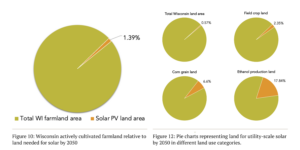
Ethanol and the future of energy farming
Farming for energy production is already common in Wisconsin, with about 37% of the corn grown used for ethanol. Wisconsin would only need to convert about 18% of corn-ethanol land to solar energy production by 2050 to achieve 28.3 GW of capacity. With a likely decrease in demand for corn-based ethanol needed by 2050 (due to the adoption of electric vehicles and substitution toward non-food crop feedstocks for biofuels), incorporating solar generation on farms is a way for Wisconsin farmers to help sustain their businesses.
A study by CLEAN Wisconsin demonstrates the efficiency of electric vehicles powered by solar energy over ethanol-powered vehicles. Their report finds that ethanol used in internal combustion engines requires about 85 times the amount of land to power the same amount of driving as solar-charged electric vehicles. Increased adoption of electric vehicles leads to decreasing gasoline demand and correspondingly diminishing the need for ethanol. With all else held constant, this trend will inexorably dampen corn prices received by the growers supplying local ethanol plants. Incorporating solar generation on farms is a way to sustain agriculture in Wisconsin, providing farmers with a stable revenue stream for years.
Co-benefits of solar energy on farms
Solar projects can provide beneficial ecosystem services to farmers and landowners in Wisconsin. Solar farms can last up to 35 years, allowing the land and soil underneath the arrays to rest and recover. Once a solar installation is decommissioned, the land can once again be farmed and will be more fertile when replanted, in contrast to residential or commercial development, which is much more permanent when complete [11]. Planting native plants and grasses amongst the arrays is becoming a standard practice, improving soil health and serving as pollinator environments.
In addition, advancements in design and technology have spurred research into agrivoltaics, or the simultaneous land use of solar energy generation and conventional agricultural activities. This co-location of activities provides many additional benefits, including dual revenue streams for the landowner and reduced heat stress on crops or grazing animals due to the shade of the solar panels. By altering the panels’ standard configurations and tilt schedules, researchers are investigating how to optimize crop yields and energy production.
Solar energy can help sustain Wisconsin farm businesses
Solar fields can supply almost one-third of Wisconsin’s electricity consumption in 2050 using a small portion of agricultural land. Nonetheless, agriculture is a significant part of Wisconsin’s economic and cultural identity, and Wisconsinites are connected to the image of Wisconsin’s landscape. As the farming industry continues to change, Wisconsin must allow farmers’ businesses to evolve. Solar developments can help family farms thrive with stable lease payments, support diverse soil health and ecosystem service benefits, and create local economic benefits. Wisconsin farmers and solar energy are helping to advance a stronger, healthier Wisconsin powered by clean energy.
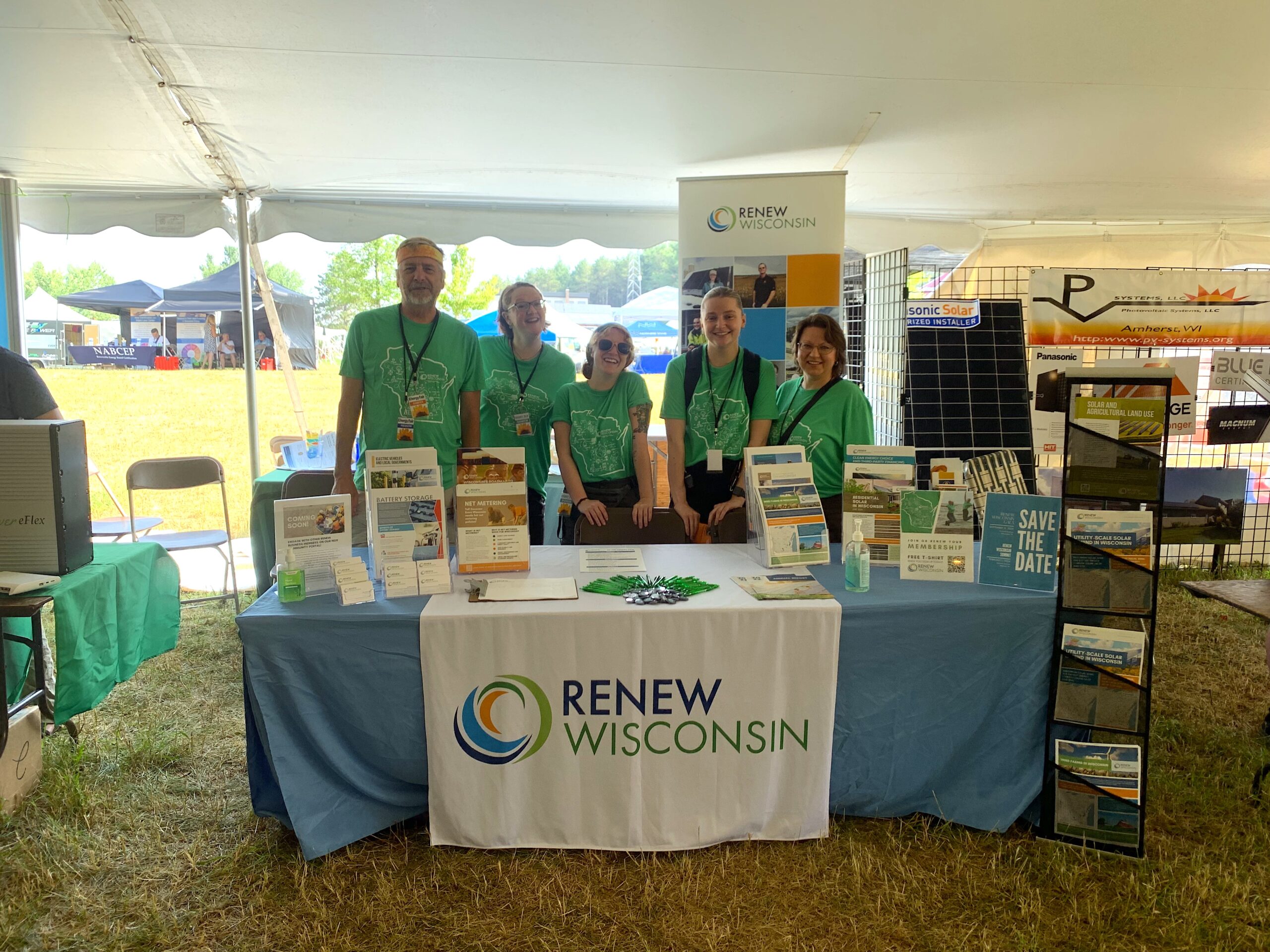
by Julia Holzschuh | Jun 27, 2023 | Electric Vehicles, Electrification, Energy Storage, Events, Inflation Reduction Act, Local Government, Netzero Wisconsin, Policy, Programs, RENEW Wisconsin, Renewables, Solar, Solar for Good, Sustainability, Utility Scale
Last weekend, the Midwest Renewable Energy Association (MREA) hosted the 32nd Annual Energy Fair, bringing people together to learn about sustainability and clean energy, connect with others, and take action toward a sustainable future. The Fair featured workshops, exhibitors, live music, inspiring keynote speakers, family fun, great local food, and more.
RENEW staff presented some compelling workshops and you can download slides from their presentations below.
Zero Carbon by 2050—A Path for Wisconsin
Andrew Kell, RENEW Policy Director, discussed zero-carbon goals and ongoing planning efforts in Wisconsin. Andrew also was a guest on a live podcast, focused on Wisconsin’s Net Zero future.
MadiSUN Workforce Training
Lauren Cohen, RENEW Program Coordinator, held a workshop regarding career growth opportunities within Wisconsin’s clean energy industry, focusing primarily on opportunities within the solar industry.
Vehicle-to-Grid: Opportunities and Challenges
Francisco Sayu, RENEW Emerging Technology Director, discussed how Vehicle-to-Grid technology unlocks the energy stored in electric vehicles and opens opportunities for energy trading, energy management, and grid resiliency.
Farming Sunshine: Solar and Ag Land Use
Nolan Stumpf, one of RENEW’s Interns, presented a session regarding solar farms and the opportunities and challenges of using the land for farming purposes and advancing clean energy.
Can Clean Energy Overcome Local Opposition?
Michael Vickerman, RENEW Clean Energy Deployment Manager, discussed the opposition clean energy faces at the local level and how to overcome those barriers.












